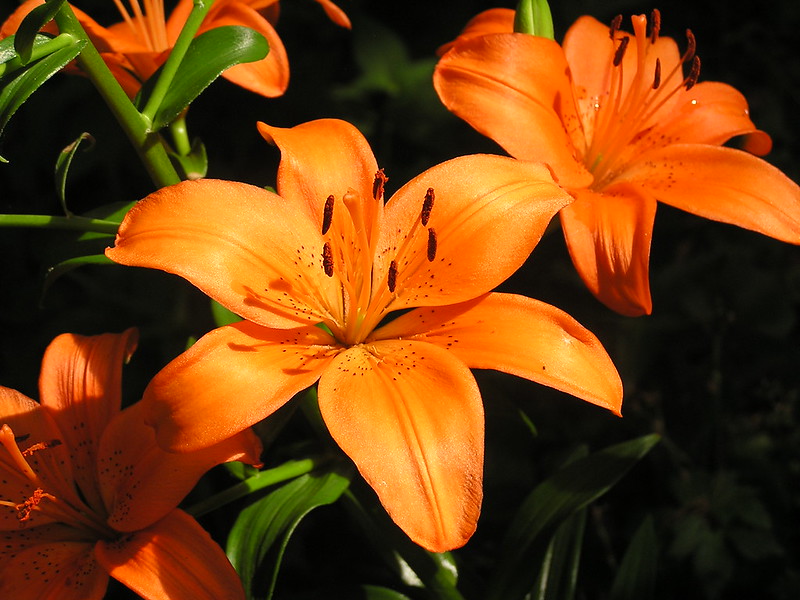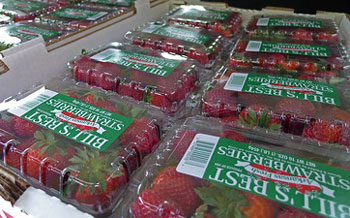April Gardening Calendar
 See what you need to do in the month of April to stay on task for gardening.
See what you need to do in the month of April to stay on task for gardening.
Searcy, Ark. –
Trees and Shrubs:
Spring flowering shrubs should be pruned–only if needed, after spring bloom. Fertilize then as well. Most shrubs will benefit from one application of fertilizer per year, and spring is a fine time to apply it. Repeated applications should not be necessary.
Annual Flowers & Vines:
Our pansies seem finally to be recovering from our winter, just in time to begin replacing them with summer color. Enjoy them as long as they last, and begin interspersing your warm season color. A new annual you may want to try is the Doublet Begonia, a lovely double flowered begonia with small rosebud like blossoms.
As you plant summer color, incorporate a complete fertilizer or a slow release fertilizer, plant and mulch. To keep annuals blooming their best, make regular applications of a water soluble fertilizer. Let the soil temperatures begin to warm up before you get sowing your annual vines.
By mid to late month, sow seeds of hyacinth vine, moon vine and cypress vines. You may also be able to find transplants at your local nursery. These vines really kick in and grow with warm weather, and can give you a beautiful display of flowers from mid-summer on.
Lawns:
The lawns they are a’bloomin’! Winter weeds are nearing the end of their growing season, and they are going out in a rush of color. Avoid any weed killers now, simply mow to keep them from setting more seeds. Your lawn is in a transition period now, changing from dormant to active growth, so avoid any chemicals which might slow things down. Fertilize with a slow release high nitrogen fertilizer to start the season off right.
Spring is an ideal time to sod a new lawn or to seed a Bermuda lawn. Prepare the site well by killing weeds and extra vegetation. Incorporate organic matter, level the site, and plant away. Water will be critical to success in the first month after planting, and weekly watering will be needed throughout the first summer.
Vegetables and Herbs:
A home vegetable garden is a wonderful way to garden, and get fresh produce. April is one of the best months to plant, since you can basically plant almost every crop. You have until mid-month to plant the cool season veggies: lettuce, spinach, broccoli, and onions; plus you can begin to plant the warm season vegetables.
Snap beans and corn can go in the ground right away, but wait until mid-month for tomatoes, peppers and eggplants. You won’t gain much by early planting, and growth will kick in once the weather is warmer, and the soil is warmer. You can speed up the soil warming process by using black plastic mulch, or simply be patient.
Download the Planting Dates for Spring and Summer Vegetable Production
Choose a site that gets a minimum of six hours of sunlight. Make sure water is nearby, and that the soil is well drained. Add a layer of compost or similar organic matter, and till it into the soil. Broadcast a complete fertilizer for all crops at planting, and then side-dress 6 to 8 weeks later.
Springtime gardening often causes us to plant more than we can care for. The delightful weather leads to all kinds of hopes and dreams. Just remember that July and August are waiting!
Mulching is your best method to prevent weeds, plus it maintains soil temperature and moisture. Insects and diseases are just beginning to appear, so monitor your plants and catch them early.
Bulbs and Corms:

As much as it may bother you, leave the foliage of spring bulbs alone, and let it grow. The 6-8 week period of foliage growth, following bloom is the time period spring bulbs need to regenerate a flower for next year. Avoid braiding, tying or otherwise trying to manage the leaves, just let them grow.
Once the six week period has passed, feel free to cut the leaves off. You don’t have to wait until they die on their own, unless you want to. Last year’s mild conditions and rainfall kept some bulb foliage around until late June, and that isn’t necessary. Everything is fairly well set six weeks after they finish flowering. Spring bulbs can be left in the ground year-round without damage–unless you cut into them planting something else! There is no reason to lift and store the bulbs.
Summer bulbs are hitting the markets now. Elephant ears, cannas and calla lilies can be planted any time. Hold off on the heat loving caladiums. Let the soil warm up a bit before you put them in the ground.
Fruits and Nuts:
 Strawberry season will begin this month for commercial producers, and should start
in your garden in a month. Commercial grown plasticulture strawberries (growing them
on rows of black plastic mulch) have an earlier season, because the black plastic
helps to warm up the soil, and start the plants growing sooner as well. It is not
a common practice in the home garden, where we simply plant a few rows of the fruits.
This way we can enjoy the early berries from the u-pick farms, and then enjoy the
home grown version a little later.
Strawberry season will begin this month for commercial producers, and should start
in your garden in a month. Commercial grown plasticulture strawberries (growing them
on rows of black plastic mulch) have an earlier season, because the black plastic
helps to warm up the soil, and start the plants growing sooner as well. It is not
a common practice in the home garden, where we simply plant a few rows of the fruits.
This way we can enjoy the early berries from the u-pick farms, and then enjoy the
home grown version a little later.
Be sure to call your local u-pick farm before heading out, to make sure fruit is available. Don’t forget the farmers markets too, they are opening all over the state, and you can sample the first harvests of local produce!
Strawberries, blueberries and blackberries are a nice addition to the home garden if you have at least six hours of sunlight a day. If you don’t have these plants growing in your garden, consider planting some. They need a well-drained, rich site. There are few pest problems with these crops.
Fruit trees are tougher to grow at home. Besides annual pruning, which all fruit crops need, fruit trees also require a rigorous spray program to combat insects and diseases. If you don’t plan to spray, don’t bother planting peaches or plums. Apples and pears are a bit more forgiving, but for quality fruit, a spray schedule is encouraged. Your local extension office has a home fruit spray guide. Investigate before you plant, so you know what you are getting into.
Learn more about home-grown fruit production in Arkansas
Perennial Flowers and Vines:
Perennials should be up and growing now. Some that like warm weather may be a bit slow, so be patient. Hardy hibiscus often don’t poke their head out of the ground until early May. If you have perennials that bloom in the summer or fall that need division, dig and divide them soon. Share any extras with your friends. Division is the easiest method of propagation. Dig up the clump and make a clean cut between crowns. Daylilies are dormant for a relatively short period of time each year. This year many plants sprouted in January and suffered some damaged foliage. Be sure that you have cut all the damaged leaves off. If they are too crowded, they won’t bloom well, so divide if needed.
New perennials are arriving at garden centers weekly. As you choose plants to incorporate, consider what season of bloom you are lacking. Helleborus orientalis, the Lenten Rose, is an Arkansas Select plant that is still in full bloom this month. This evergreen perennial prefers the shade, and grows only during the cool months. After bloom, (late February to mid-May) it will retain its green foliage, but it won’t put on any more leaves until next winter.
Container plants:
By mid-month you can move all your houseplants outside. This is also the season to plant containers, so plant away. Keep in mind that you should have a vertical element, a filler, and something that cascades out of the pot. Try new combinations and add as much color as you can.
Check out our page on container gardening for more tips!
By Sherri Sanders
White County Extension Agent - Agriculture
The Cooperative Extension Service
U of A System Division of Agriculture
White County Cooperative Extension Service
2400 Old Searcy Landing Rd. Searcy, AR 72143
(501) 268-5394
ssanders@uada.edu